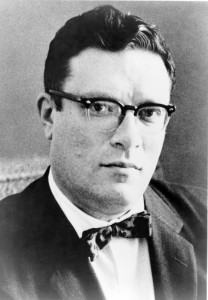By The Metric Maven
Isaac Asimov Edition
One Sunday, I was attending my weekly coffee klatch, when one of the participants asked: “Who besides you thinks millimeters should be used instead of centimeters?” I was rather surprised at the question, even though I’m the resident metric advocate. I blurted out “Well, Isaac Asimov does for one, so does the U.S. metric building code, the late Pat Naughtin did, and so did Herbert Arthur Klein in his book The Science of Measurement.” The person who asked the question has a solid scientific background, and what surprised me about the question was the appeal to authority. I have found it very puzzling that when I explain the situation, people do not seem to absorb its meaning, or don’t really think about the simplified symbolic expression.
First, lets start with authority. In his 1983 book The Measure of The Universe, Isaac Asimov has this to say about the centi prefix:
The prefix “centi” (SEN-tih), symbolized as “c,” represents a hundredth of a basic unit, from the Latin “centum” meaning “hundred.” A “centimetre,” therefore, is a hundredth of a metre. The prefix is not commonly used, except in “centimetre,” and its use is falling off even there.
Isaac Asimov has this to say about the milli prefix:
The prefix “milli” (MIL-ih), from the Latin “mille,” meaning “thousand,” is symbolized as “m,” just as “metre” is. A millimetre is therefore symbolized as “mm.” Increasingly “milli-” is replacing “centi-” and “deci-” in use. We are approaching the point where 1 centimetre will routinely be referred to as 10 millimetres, and 1 decimetre as 100 millimetres. This is even more true where these prefixes are used for any basic measure other than “metre.”
There it is, documented with sans serif typeface, Isaac Asimov asserting the utility of the milli prefix over the centi prefix. Asimov also had this to say in his essay “Read Out Your Good Book In Verse” in his 1984 book X Stands for Unknown:
Light wavelengths have traditionally been given in “Angstrom Units,” named in 1905 for the Swedish physicist Anders Jonas Ångström (1814-74), who first used them in 1868. An Angstrom unit is one ten-billionth of a meter, or 1 x 10−10 meters.
Nowadays, however, it is considered bad form to use Angstrom units because they disrupt the regularity of the metric system. It is considered preferable now to use different prefixes for every three orders of magnitude, with “nano” the accepted prefix for a billionth (10−9) of a unit.
In other words, a “nanometer” is 10−9 meters, so that one nanometer equals 10 Angstrom units. If a particular light wave has a wavelength of 5,000 Angstrom units, it also has a wavelength of 500 nanometers, and it is the latter that should be used.
Again Asimov asserts the importance of using metric prefixes with separations of three orders of magnitude.
Nine years earlier in 1974, Herbert Arthur Klein, in his book The Science of Measurement, wrote this about the metric prefixes:
Herbert Klein sees the atavistic magnifying prefixes deka, hecto, and myria as unnecessary and implies that separations by 1000 are best. He sees only milli as a reducing prefix in good standing, and again argues for reduction by factors of 1000.
Pat Naughtin spent considerable time exploring why millimeters worked so much better than centimeters when implemented in industry. When millimeters were used, the metric transition was quick and almost painless. The introduction of centimeters would delay metric adoption almost indefinitely. He wrote a long discussion of this in 2008 and pleaded for people to use millimeters.
Long time readers know that when the issue was explained to me, and I used millimeters and millimeter instruments in my own engineering work (sans centimeters); I became convinced that the centi prefix, and centimeters are considerable intellectual barriers to metric adoption in the U.S..
After I understood the problem with centimeters, it seemed obvious to use millimeters, but as Isaac Asimov states in his 1971 book The Stars in Their Courses:
One of the pitfalls to communication lies in that little phrase “It’s obvious!” What is obvious to A, alas, is by no means obvious to B and is downright ridiculous to C.
I’m going to do my best to return to my unexamined world view and try to explain the epiphany that struck me at Mach III+. Below is an image from a newspaper film box, probably from the 1970s. The film size is in inches, and it is converted to metric in centimeters.
The film size is 45.7 x 58.4 centimeters. The number of symbols used is four for each linear dimension. In the everyday world, a measurement with only the precision of a centimeter, is generally too coarse to be of any practical use. The odds that one will measure to an even centimeter are rather low, and so almost all common measures in our world require an unnecessary decimal point and a value for a tenth of a centimeter.
But a tenth of a centimeter is a millimeter. This implies that everyday measurement is generally useful only to a millimeter value. When 45.7 cm and 58.4 cm are written in millimeters, only three symbols are required to express the very same value of length: 457 mm x 584 mm. The mind does not need to stop and perceive the location of a decimal point and parse the decimal number. The number of symbols used is reduced from four to three.
The objection often offered is that one only has to move the decimal point to change from millimeters to centimeters! Pat Naughtin pointed out that often people who work on construction are less familiar with manipulating numbers than scientifically trained professionals. Asking them to slither a decimal point along in any calculations they might do, will only introduce an opportunity for error. In the case of centimeters, the error can be very large because of the unit size chosen.
But, indeed, the proof of the pudding is in the eating, and so it is with the millimeter and the metric system. Pat Naughtin has an extensive discussion (50 pages) about millimeters versus centimeters. His original observation was an empirical one: Industries that used the millimeter had quick and smooth metric transitions, those that chose the centimeter are still in turmoil to this day. Why is this the case? It was analysis after-the-fact that offered clues.
Naughtin makes this observation:
Talking or arguing with people who have not done any measuring with the metric system is quite pointless. But as soon as they experience the simplicity of the metric system for themselves they will then convince themselves that it is the better
Sven had lobbied for the use of millimeters, but it was only when I had all-millimeter rulers and instruments, that I realized their utility, and adopted millimeters exclusively.
I continue to have people who are from “metric countries,” who, with an air of sanctimoniousness say “I’ve never had a problem with centimeters. I use them all the time.” They don’t seem to realize I could just as easily say I’ve used inches (feet, yards, rods, miles) here in the U.S. and I’ve never had a problem. Or stating that “I can use Roman numerals, and have for years,” with the implication that your mind is obviously too small and dim to handle them. Not that they are in fact awkward. It took about 1000 years for people to realize there was a problem with Roman Numerals. They never saw a problem because the were immersed with them. These denizens of “metric countries,” have an antique metric system usage, that is contemporary with Þe Olde English, and they are fine with the retention of familiarity over simplicity. There is no examination or self-reflection, just a thoughtless assertion. References are offered, reasons explained, and the response appears to be reactionary truthiness, rather than thoughtful introspection.
Certainly Isaac Asimov has demonstrated that he is trustworthy, but I’m sure he would also indicate that a person should never take his word alone. It is always best to understand an idea directly. The question should not be who says?! but why.
Related essays:
If you liked this essay and wish to support the work of The Metric Maven, please visit his Patreon Page and contribute. Also purchase his books about the metric system:
The first book is titled: Our Crumbling Invisible Infrastructure. It is a succinct set of essays that explain why the absence of the metric system in the US is detrimental to our personal heath and our economy. These essays are separately available for free on my website, but the book has them all in one place in print. The book may be purchased from Amazon here.

The second book is titled The Dimensions of the Cosmos. It takes the metric prefixes from yotta to Yocto and uses each metric prefix to describe a metric world. The book has a considerable number of color images to compliment the prose. It has been receiving good reviews. I think would be a great reference for US science teachers. It has a considerable number of scientific factoids and anecdotes that I believe would be of considerable educational use. It is available from Amazon here.

The third book is called Death By A Thousand Cuts, A Secret History of the Metric System in The United States. This monograph explains how we have been unable to legally deal with weights and measures in the United States from George Washington, to our current day. This book is also available on Amazon here.






